Refraction Through a Prism
Refraction Through a Prism: Overview
This topic covers concepts, such as Prism, Deviation by Prism, Deviation versus Incident Angle Graph in Prism, Condition for Minimum Deviation in Prism and Refractive Index Formula for Prism.
Important Questions on Refraction Through a Prism
A thin prism of angle is placed at a distance of from the object. The distance of the image from the object is (given of prism)
A prism has a refractive index and refracting angle . Find the minimum deviation produced by prism
A ray incident at angle 53o on a prism emerges at an angle at 37o as shown. If the angle of incidence is made 50o, which of the following is a possible value of the angle of emergence.
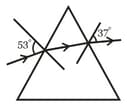
A parallel beam of light falls normaly on the first face of a prism of small angle. At the second face it is partly transmitted and partly reflected, the reflected beam striking at the first face again, and emerging from it in a direction making an angle 6o 30' with the reversed direction of the incident beam. The refracted beam is found to have undergone a deviation of 1o 15' from the original direction. Find the refractive index of the glass and the angle of the prism.
The refractive indices of the crown glass for violet and red lights are and respectively and those of the flint glass are and respectively. A prism of angle is made of crown glass. A beam of white light is incident at a small angle on this prism. The other thin flint glass prism is combined with the crown glass prism such that net mean deviation is anticlockwise.
A screen is placed normal to the emerging beam at a distance of from the prism combination. Find the distance between red and violet spot on the screen. Which is the topmost colour on screen.
How does the angle of minimum deviation of a glass prism vary, if the incident violet light is replaced with red light?
A ray of light undergoes deviation of when incident on an equilateral prism of refractive index What is the angle subtended by the ray inside the prism with the base of the prism is ?
A given ray of light suffers minimum deviation in an equilateral prism . Additional prism and of identical shape and of the same material as are now added as shown in the figure. The ray will now suffer

A given ray of light suffers minimum deviation in an equilateral prism . Additional prism and of identical shape and of the same material as are now added as shown in the figure. The ray will now suffer

The maximum refractive index of a prism which permits the passage of light through it, when the refracting angle of the prism is is
For the angle of minimum deviation of a prism to be equal to its refracting angle, the prism must be made of a material whose refractive index
When a beam of white light passes through a prism it gets
A ray of light falls on one of the lateral surface of an equilateral prism placed on a horizontal surface on a table as shown in the figure. For minimum deviation of the ray, which of the following is true?
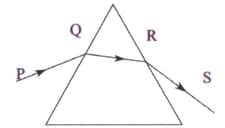
A ray of light makes normal incidence on the diagonal face of a right angled prism as shown in figure . If then the angle of deviation is
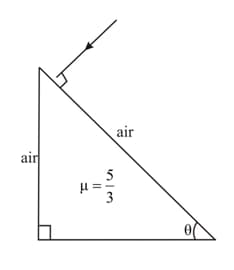
A ray of light passes through an equilateral glass prism in such a manner that the angle of incidence is equal to the angle of emergence and each of these angles is equal to of the angle of the prism. The angle of deviation is
Consider two equivalent, triangular hollow prisms A and B made of thin glass plates and arranged with negligible spacing as shown in the figure. A beam of white light is incident on prism A from the left. Given that, the refractive index of water is inversely related to temperature, the beam to the right of prism B would not appear white, if
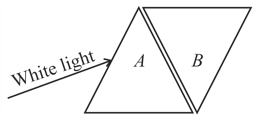
Maximum deviation occurs in a homogeneous prism of refracting angle and having critical angle of its material as when the angle of incidence is -
A light ray incidents normally on one surface of an equilateral prism. The angle of deviation of the light ray is (Refractive index of the material of the prism )
The figure shows the graph of an angle of deviation versus the angle of incidence for a light ray striking a prism. The prism angle is,
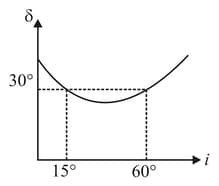
A prism of refractive index has refracting angle . Angle of maximum deviation is
